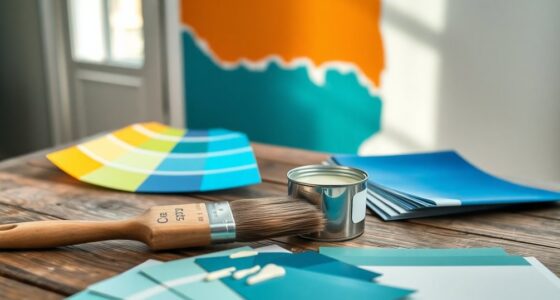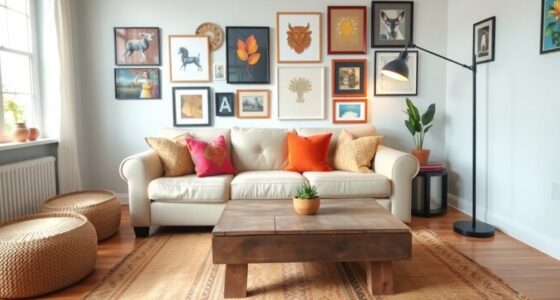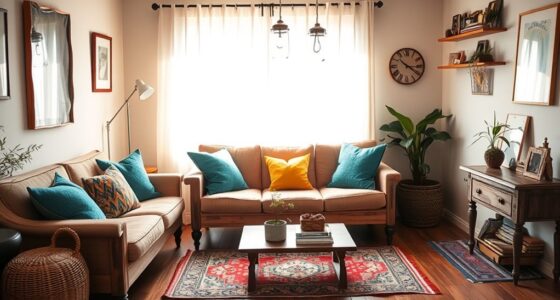Upcycling old furniture is a great way to breathe new life into worn pieces and make them trendy again. Start by cleaning, sanding, and priming surfaces, then choose a paint technique, like chalk or high-gloss, to achieve your desired look. Replace outdated hardware with modern or vintage finds to boost style. Finish with a protective coat to guarantee durability. Keep exploring these tips to master the art of creating personalized, stylish furniture that’s both fun and eco-friendly.
Key Takeaways
- Start by cleaning, sanding, and priming furniture for a smooth, prepared surface.
- Choose suitable paint techniques like chalk or high-gloss for desired finishes.
- Update hardware with stylish knobs or handles to instantly refresh the piece.
- Seal with protective topcoats to enhance durability and maintain the new look.
- Experiment with layering, stenciling, and decorative touches to personalize your upcycled furniture.

Upcycling furniture is a creative way to breathe new life into old or worn pieces while reducing waste. It’s about transforming something that might be destined for the trash into a stylish, functional part of your home. To start, you’ll want to explore different painting techniques to refresh your furniture’s appearance. Whether you choose chalk paint for a matte, vintage look or a sleek, high-gloss finish, your options are limitless. Using brushes, rollers, or even spray paint, you can create textured effects, distressed finishes, or smooth surfaces that match your personal style. Proper preparation is key—clean the surface thoroughly, sand any rough spots, and prime if necessary, to make sure your paint adheres well and lasts longer. Don’t be afraid to experiment with layering colors or adding decorative stenciling; these techniques add depth and personality to your piece. Additionally, understanding tanning bed risks and taking precautions can be essential for maintaining healthy skin if you’re outdoors or using artificial tanning methods. Hardware replacement is another essential step in upcycling furniture. Outdated or broken hardware can make a piece look tired, but swapping it out is quick and impactful. You might find vintage knobs or modern handles at craft stores or salvage yards that perfectly suit your new design. When replacing hardware, measure carefully to ensure new pieces fit existing holes or be prepared to drill new ones. This small update can completely change the character of the piece, giving it a fresh, contemporary vibe or restoring its classic charm. Consider choosing hardware in different finishes—brushed gold, matte black, or antique brass—to complement your paint job and overall decor. Once you’ve chosen your painting techniques and updated the hardware, it’s time to assemble everything. Apply a protective topcoat, like a clear wax or polyurethane, to seal your work and enhance durability. This step is especially important if the furniture will see regular use or if you’ve applied a matte or chalk paint that needs extra protection. Additionally, learning about asset division laws can help you understand how to handle any valuable items or collectibles you might include in your project. Embracing upcycling techniques can also inspire you to explore various creative ideas and expand your skills further. For example, researching painting techniques and leverage in painting techniques can help you achieve professional-looking results more efficiently, especially if you want to scale up your projects. As you finish, step back and evaluate your piece, making any touch-ups needed to perfect the look. Upcycling isn’t just about saving money; it’s about expressing your creativity and making something uniquely yours. With a little effort, patience, and the right techniques, you’ll turn an ordinary piece of furniture into a trendy, personalized statement for your home.
Frequently Asked Questions
What Tools Are Essential for Beginner Upcyclers?
When starting out, you need essential tools like a screwdriver, sandpaper, and paintbrushes. Don’t forget safety gear such as gloves and a mask to protect yourself. Setting up a proper workspace with good lighting and a sturdy surface makes your project easier and safer. These basic tools and safety precautions help you confidently upcycle furniture, transforming old pieces into stylish new favorites while keeping safety a top priority.
How Do I Choose the Right Paint for Furniture?
Imagine you’re restoring a vintage chair. To choose the right paint, consider the furniture’s use and your desired finish. For example, a matte finish works well for a rustic look, while a glossy finish adds elegance. Pay attention to paint finishes and color selection, ensuring they suit your style and the piece’s purpose. Test small areas first to see how the color and finish interact under different lighting conditions.
What Are Eco-Friendly Upcycling Techniques?
You can embrace eco-friendly upcycling techniques by focusing on recycling materials and sustainable practices. Use non-toxic, low-VOC paints, and repurpose existing furniture parts to minimize waste. Incorporate natural finishes like beeswax or plant-based oils, and choose recyclable or biodegradable hardware. By prioritizing recycled materials and eco-conscious products, you reduce your environmental impact while creating stylish, sustainable pieces that reflect your commitment to the planet.
How Long Does an Upcycling Project Typically Take?
Think of an upcycling project as planting a garden; it needs time to grow. Typically, projects take anywhere from a few hours to several days, depending on size and complexity. Timing considerations are vital for effective project planning. You’ll want to set aside enough time for prep, painting, and drying, ensuring a smooth process. With proper planning, you’ll enjoy a beautiful, eco-friendly piece sooner than you expect.
How to Price Upcycled Furniture for Sale?
When pricing upcycled furniture for sale, you should start with solid pricing strategies. Conduct market research to understand what similar pieces go for in your area. Consider your costs, time, and craftsmanship, then set a competitive yet profitable price. Don’t forget to account for unique features or custom touches that add value. Regularly review market trends to adjust your prices accordingly, ensuring you stay competitive and maximize your profits.
Conclusion
Now that you know how to upcycle furniture, it’s time to get started. Remember, a fresh coat of paint and a bit of creativity can turn old pieces into eye-catching treasures. Don’t be afraid to experiment and make mistakes — after all, Rome wasn’t built in a day. As the saying goes, “Every master was once a beginner,” so keep practicing, stay patient, and soon you’ll be creating stunning, trendy furniture that’s uniquely yours.









